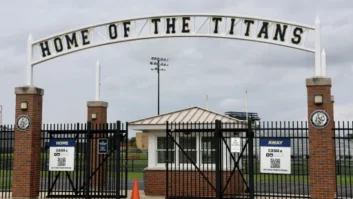Since 1922, WGN (then known as WDAP) has been broadcasting in Chicago, initially on 833 kHz, and since 1927, on 720 kHz on the AM dial.
WGN Radio is part of Tribune Broadcasting and is the company’s sole remaining radio station. Its history is long and storied, but one thing has been the same since 1924 — the famous call letters that stand for, “World’s Greatest Newspaper.” This moniker was on the front page of the Chicago Tribune for decades, but last year, Tribune Media (parent of Tribune Broadcasting) split from Tribune publishing, and WGN is no longer co-owned with the newspaper. Centrally located in the Tribune tower in downtown Chicago, WGN has a “walk of fame” marker along Michigan Avenue with a number of its legends enshrined in the walk.

Bill Murdoch of WGN Engineering
WGN is in a unique position because they are a top-rated standalone radio station in a major market. They are co-owned with over 40 television stations in 33 cities including New York, Los Angeles, Chicago, Houston, Dallas and Washington, D.C. WGN has been in its current facility since July 1, 2012 and completed a move from the ground floor to the seventh floor to give WGN a state-of-the-art facility, while maintaining continuity for programming with multiple sources and precise timing.
NEVER MISSED A TONE
Every facility has an interesting story behind it, and WGN is no exception. WGN takes time very seriously. Many years ago, WGN engineering constructed a top-of-the-hour time generator to give a very specific tone at the top of the hour. This tone consists of three frequencies mixed together and has been a hallmark of WGN Radio ever since.
You have a clear line of sight into Studio A from this producer room.
Generally, WGN runs a 10-second delay, so the tone generator makes tones twice an hour, first at :59:50, so the talent can hear the tone in their headphones and monitoring, and then a second tone is generated at :00:00 for the air chain. Even while running multiple time tones for monitoring and on-air during the move from the first-floor facility to the seventh floor, WGN never missed a single tone.

The programming, news and operations departments, as well as the engineers Bill Murdoch, Jim Holland, Jim Carollo and Bill Maylone, all took part in the design phase for the project and decided on a WheatNet-IP infrastructure for the future of WGN Radio. The new facility took time to design because WGN’s workflow required 10 studios with five newsroom workstations.
When it all came together, WGN rebuilt three on-air studios with integral producer and operator booths; two production studios; two editing rooms; a business studio; a sports studio; a traffic studio; and a newsroom with five workstations.
WGN Engineering decided on the Wheatstone E-6 consoles throughout the majority of the facility. The E-6 control surface is part of the WheatNet-IP Intelligent Network. For a station like WGN that requires a high degree of functionality, the console’s four stereo mix buses, four mix-minus buses, four AUX buses, eight-character fader displays, “bus-minus� on all faders with talkback, fit the requirements well. WheatNet SideBoards are used in the newsroom for four workstations, and in business, sports, traffic and in the producer rooms. A Wheatstone A-6000 analog console in the showcase studio rounds out the facility’s console family.
ALL THE SOURCES
WGN shares several resources with co-owned WGN(TV), from the ENG trucks to satellite downlinks.
Additionally, the station broadcasts some shows during which the talent is on TV and radio at the same time. With the WheatNet-IP, the station can do all manner of mix-minus setups easily.
Forty-eight blades make up the WGN WheatNet-IP system; most of the Blades are found in the rack room, with the remainder of the system found on the first and seventh floors, and in the TV station, located 5.5 miles away. The WGN system includes nine Console Mix-Engine Blades, 26 Analog Blades and two AES/Analog Combo Blades. It supports 284 stereo inputs and outputs.
COMPLEX REQUIREMENTS
WGN rack room, featuring incoming/outgoing ISDN units, Comrex Access and WheatNet Blades.Besides the WheatNet-IP system, WGN has a sophisticated multi-camera video feed that shows the main studio in three different HD camera angles. In addition, other cameras are used to develop a combined image of the news, traffic, sports and business studios.

WGN’s video system puts seven cameras on the air simultaneously. The screen is divided into four quadrants with three cameras showing the on-air studio, and a smaller box on the lower right with the News, Traffic, Sports, and Business studios. The video system uses Panasonic PTZ cameras, an Evertz front-end, a BlackMagic router and a Livestream streamer. The video stream can be viewed at www.wgnradio.com; click the “watch� button.
Because talk is a staple for WGN, a Telos VX system is an integral part of the system, with a number of features that enable the system to work as required for WGN. A couple of tweaks were needed for the system, and Telos stepped right up. The call screening software was changed to have different colors for different call states (ringing, on hold, on-air, and screened hold). It was a bit of a challenge to migrate the legacy choke-network calling system to the SIP trunks, but the switch was worth it. Lines come in on a T1, DSL and finally, POTS. This gives WGN the best quality available and the flexibility to grab and move lines if necessary and redundancy, if part of the system should fail.
WGN also originates “Kap and Haugh,” a sports cable-TV show for Comcast Sportsnet Chicago, for three hours per day, with five Panasonic PTZ cameras and a TriCaster 8000 switcher.
Talent at WGN sometimes likes to move between studios (and floors). One day, the showcase studio on the first floor is the desired location; on another, the seventh floor studios are more suited.
The station is also the flagship for the Chicago Blackhawks and Northwestern University teams. Upon occasion, a Blackhawks game will air on 720, while station staff feed NU games to another station.
All of this studio switching is easy now with the WheatNet system. It used to take racks of relays to do the following when studios are switched: Switch the on-air phone lines to the correct studio, put the production lines on the other studios, switch the four mix-minuses to the remotes, switch the feed to the Internet stream, switch the cameras on the in-house video system, and finally switch the studio that feeds the air-chain.
TIME FOR TOUCHSCREENS
Midday Personality Wendy Snyder with Newsman Steve Bertram.
Most recently, WGN just finished installing WideOrbit as its automation system. This system replaced an AudioVault that served WGN for many years. A big advantage of WideOrbit is the integration between traffic and the audio automation system because WGN also uses the WideOrbit traffic system.

The installation went very well, and the entire library was moved from the old system to the new with few glitches. The WideOrbit Automation system has touch screens, and the talent was able to operate the system with minimal training. Now, WGN can run spots on one console channel, hotkeys on another channel and preview through an external speaker.
The architecture of WideOrbit Automation lets WGN run updates to the server while the machine on the air happily bounces to “Island Mode” without a glitch. This temporary state of isolation from the network is possible because the audio to be played resides on the computer associated with the on-air studio.
As a flagship for the Chicago Blackhawks, WGN ran into an issue with audio it sends to the United Center where the Blackhawks play. During games, some commercials need to be removed from the stadium feed (since it is used for the public address systems) and WideOrbit automation is able to accommodate that need.
All studios were furnished with in-state manufacturer RAM Broadcast Systems, which is based out of Volo, Ill. Listen and watch WGN online at www.wgnradio.com.
Bill Murdoch contributed to this article.







